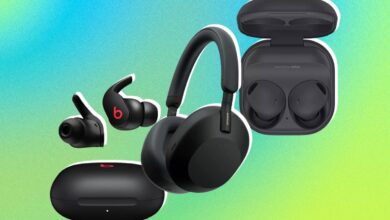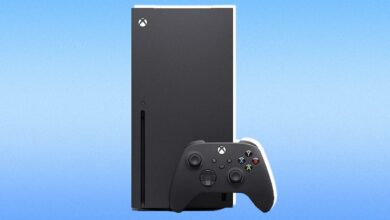Apple studio display review: Six speakers and a sharp camera make this everything we’ve been waiting for

Apple has not made a display for normal people for more than five years. It is a shocking fact – especially given how highly-regarded its screens are, and how central they are to the experience – and a state of affairs that has led to confusion and frustration for anyone who wanted a good experience out of the brand’s headless computers.
Now Apple has, finally, rectified that issue. The new studio display (£1,499, Apple.com) is a delightful return to form for the company, answering not only the question of where its screens had gone, but plenty more besides.
The studio display arrived alongside the Mac studio (£1,999, Apple.com), and the two sit very neatly next to each other. But the screen will also work well with any of Apple’s recent computers, from the cheaper headless Mac mini (£622.97, Amazon.co.uk) to as an extra display for a MacBook or even an iPad.
At £1,499, the new studio display is actually Apple’s cheaper model. It joins its sibling in the pro display XDR (£4,599, Apple.com) which is larger, more detailed and accurate, and includes professional features that mean Apple charges as much as £5,499 for one without a stand.
We have been using the studio display for the past week, for both daily use as well as for specific tasks intended to test its performance. We looked not only for the picture quality but also ease of use, sound and the performance of the built-in camera. It has been plugged in not only to the new Mac studio, which is reviewed here, but to a range of other Apple products including an iPad to test compatibility.
Read more:
You can currently pre-order the Apple studio display (£1,499, Apple.com) until Friday 18 March, when it officially launches.
Rating: 9/10
Like the Mac studio (£1,999, Apple.com) it comes alongside, the studio display is not necessarily a beautiful thing. Switched off, and viewed from the front, it is a 27in black rectangle on an elegant aluminium stand; from the back, it is a silver rectangle with a black Apple logo.
In other words, it looks exactly like an Apple display, and isn’t trying to be anything else. In recent times, Apple has been criticised for a focus on beauty that has come at the expense of practicality; there is none of that here. It looks nice, but not excessively so.
Switch it on, and the display will light up with a rich 5K experience that is bright and vivid. The 14.7 million pixels inside glow with a billion colours that are ready for everything from the most intense work to watching films.
Read more: Apple MacBook pro – a radical update that’s miles ahead of the competition
The inclusion of Apple’s true tone technology is a quiet delight, too, meaning that the colours of the screen will adjust with the light, and white will always look truly white. Similarly, an anti-reflective coating means that you’ll never be able to see yourself in the screen, and you can pay more for a “nano-texture”, which keeps even bright light from showing up as glare.
Technically, the display is satisfactory and little more: it has support for a wide variety of reference modes, colour accuracy that will be decent enough for most design work, and with 600 nits of brightness it can glow enough for most uses though could sometimes do with a little more energy. There’s no support for fancier features, such as HDR, despite it being present in most other new and professional Apple displays.
The main reason the studio displays might not feel good enough is if you have ever had the opportunity to look at Apple’s pro display (£4,599, Apple.com). That is so bright, rich and precise that it has the effect of spoiling other screens. But it also costs about four times as much.
This is the striking, luminous Apple display for everyone else. As a screen, it does exactly what you expect of it – no more, no less – but people have been asking for exactly that for a very long time.
In the back of the studio display is a power cable that cannot be removed, plus three USB-C ports and one for Thunderbolt. The latter is where your computer plugs in, and the display can charge your MacBook when it is attached, making attaching and detaching from the display incredibly easy.
You can then plug whatever other things into those USB-C ports, from external drives to printers. They can stay plugged in, and any MacBook or other computer will be able to see them –once again, meaning that you can just detach your computer and go.
Again, the studio display and Mac studio arrived together, and work very neatly as a pair. But the screen is a great partner for any recent Mac, from any MacBook to the Mac studio’s headless siblings, the Mac pro (£5,499, Apple.com) and the Mac mini (£622.97, Amazon.co.uk).





